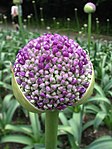en
names in breadcrumbs


Allium giganteum, common name giant onion, is an Asian species of onion, native to central and southwestern Asia but cultivated in many countries as a flowering garden plant.[4][5] It is the tallest species of Allium in common cultivation, growing to 1.5 metres (4.9 ft).[6]
In early to midsummer, small globes of intense purple umbels appear, followed by attractive fruiting umbels. A popular cultivar, 'Globemaster', is shorter (80 centimetres (31 in)) but produces much larger, deep violet, umbels (15–20 centimetres (5.9–7.9 in)). Both varieties have been granted the Royal Horticultural Society's Award of Garden Merit.[7][8][9]
In nature, the species is found in Iran, Afghanistan, Turkey, Turkmenistan, Tajikistan, and Uzbekistan.[3] In cultivation in the US, it performs well in USDA hardiness zones 6–10.[10]
Eating flowers, seeds, leaves, and stems can cause nausea, vomiting, and diarrhea due to the sulfides they contain.[11]
Allium giganteum, common name giant onion, is an Asian species of onion, native to central and southwestern Asia but cultivated in many countries as a flowering garden plant. It is the tallest species of Allium in common cultivation, growing to 1.5 metres (4.9 ft).
In early to midsummer, small globes of intense purple umbels appear, followed by attractive fruiting umbels. A popular cultivar, 'Globemaster', is shorter (80 centimetres (31 in)) but produces much larger, deep violet, umbels (15–20 centimetres (5.9–7.9 in)). Both varieties have been granted the Royal Horticultural Society's Award of Garden Merit.
In nature, the species is found in Iran, Afghanistan, Turkey, Turkmenistan, Tajikistan, and Uzbekistan. In cultivation in the US, it performs well in USDA hardiness zones 6–10.
Eating flowers, seeds, leaves, and stems can cause nausea, vomiting, and diarrhea due to the sulfides they contain.

Flower opening

Flower fully open